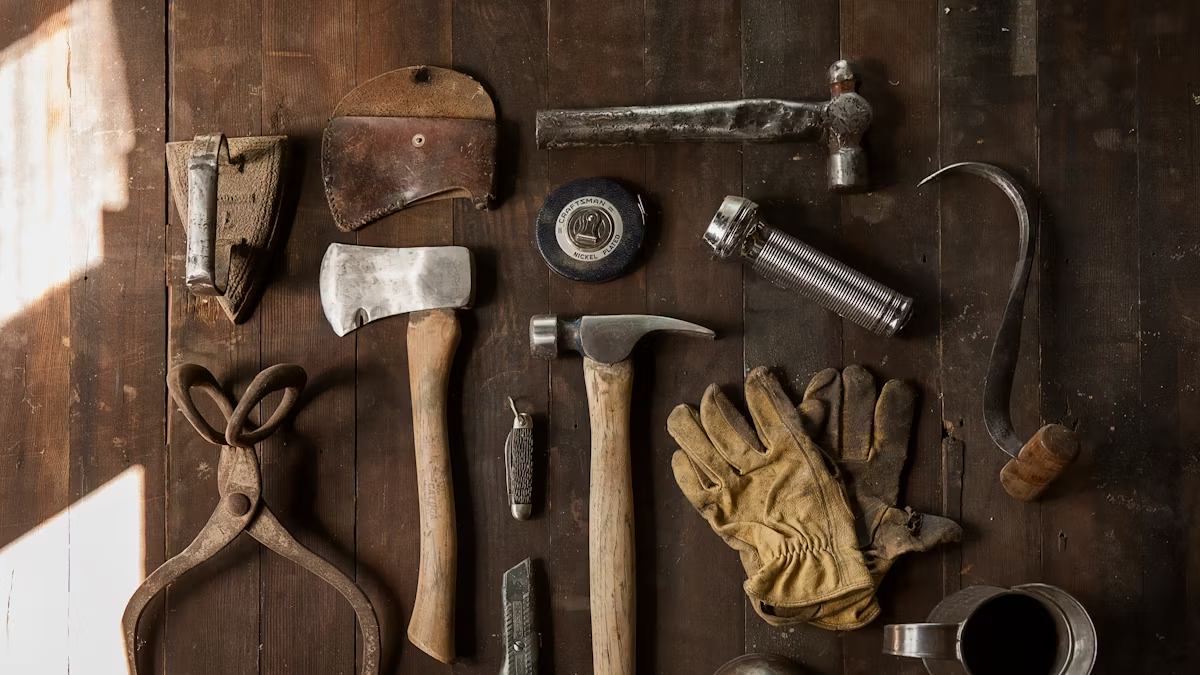
Railway hand tools play a crucial role in the maintenance and construction of railways. These tools ensure the smooth operation and safety of railway tracks. Workers use various tools, such as sledgehammers and switch brooms, to perform essential tasks on the track. The railway industry relies on these tools for manual activities, making them indispensable for track work. Proper use of these tools enhances efficiency and reduces the risk of accidents, contributing to the overall safety and reliability of railway operations.
Railway Hand Tools for Track Maintenance

Track Wrenches
Function and Types of Track Wrenches
Track wrenches serve a crucial role in railway maintenance. Workers use these tools to tighten or loosen bolts and nuts on railway tracks. Properly secured bolts ensure track stability and safety. Track wrenches come in various types, including adjustable and fixed-head wrenches. Adjustable wrenches offer flexibility for different bolt sizes, while fixed-head wrenches provide a secure fit for specific sizes.
Proper Usage and Safety Tips
Proper usage of track wrenches involves selecting the correct size for the bolt. Incorrect size selection can lead to slippage and potential injury. Workers should always inspect the wrench for damage before use. Damaged tools can fail during operation, posing a safety risk. Always apply force steadily to avoid sudden movements that could cause accidents. Wearing protective gloves can enhance grip and reduce the risk of hand injuries.
Rail Tongs
Function and Types of Rail Tongs
Rail tongs are essential for handling continuous welded rail (CWR). These tools clip automatically onto the rail being moved. Rail tongs are designed to be fastened to hauling and rail removal equipment. Made of high-tensile Swedish steel, rail tongs are lightweight and portable. Workers can easily move these tools on and off-site. Rail tongs hold rails for removal from rail trains and position rails accurately for welding.
Proper Usage and Safety Tips
Using rail tongs correctly involves ensuring a secure clip onto the rail. Workers should check the tongs for any signs of wear or damage before use. Damaged tongs can fail to hold the rail securely, leading to accidents. Always lift with proper posture to avoid back injuries. When moving rails, workers should communicate clearly to coordinate efforts and prevent mishaps. Wearing safety boots can protect feet from heavy rail impacts.
Track Jacks
Function and Types of Track Jacks
Track jacks lift and align railway tracks during maintenance. These tools help in adjusting the track’s position for proper alignment. Track jacks come in hydraulic and mechanical types. Hydraulic jacks offer ease of use with less physical effort. Mechanical jacks provide a more manual approach but are equally effective.
Proper Usage and Safety Tips
Proper usage of track jacks requires placing the jack base on a stable surface. An unstable base can cause the jack to tip over during operation. Workers should ensure the jack is rated for the weight of the track section being lifted. Overloading a jack can lead to equipment failure and accidents. Always lift gradually to maintain control and avoid sudden movements. Using protective gear, such as gloves and helmets, can enhance safety during operation.
Railway Hand Tools for Fastening
Spike Mauls
Function and Types of Spike Mauls
Spike mauls play a vital role in securing railroad tracks. Workers use these tools to drive railroad spikes into wooden ties, ensuring track stability. Spike mauls resemble sledgehammers but have elongated double-faced hardened steel heads. These tools typically weigh between 8 to 12 pounds and have handles ranging from 30 to 36 inches in length. Popular brands include Slug-Devil, Tamco, and Warwood.
Proper Usage and Safety Tips
Proper usage of spike mauls involves selecting the right weight for the task. Heavier mauls drive spikes more efficiently but require more physical effort. Workers should inspect the maul for any damage before use. Damaged heads or handles can lead to accidents. Always wear protective gloves to enhance grip and reduce the risk of hand injuries. Using a steady, controlled swing helps prevent missed strikes and ensures accurate placement of spikes. Safety boots protect feet from accidental drops.
Rail Drills
Function and Types of Rail Drills
Rail drills are essential for creating holes in rails for bolts and fasteners. These tools ensure precise drilling, which is crucial for maintaining track integrity. Rail drills come in various types, including manual and powered versions. Manual rail drills offer portability and ease of use in remote locations. Powered rail drills, such as electric or hydraulic models, provide faster and more efficient drilling.
Proper Usage and Safety Tips
Proper usage of rail drills requires selecting the appropriate drill bit for the rail material. Incorrect bit selection can lead to inefficient drilling and potential damage. Workers should secure the rail firmly before drilling to prevent movement. Always inspect the drill and bits for wear and damage. Worn-out bits can break during operation, posing a safety risk. Wearing safety goggles protects eyes from metal shavings. Using ear protection reduces the risk of hearing damage from prolonged drilling noise.
Bolt Cutters
Function and Types of Bolt Cutters
Bolt cutters are indispensable for cutting through bolts, chains, and other metal fasteners. These tools feature long handles and hardened steel jaws, providing the leverage needed to cut through tough materials. Bolt cutters come in various sizes, with larger models offering greater cutting capacity.
Proper Usage and Safety Tips
Proper usage of bolt cutters involves positioning the jaws around the bolt or chain to be cut. Applying steady pressure on the handles ensures a clean cut. Workers should inspect the jaws for any signs of wear or damage before use. Damaged jaws can slip, leading to potential injury. Always wear safety gloves to protect hands from sharp edges and flying debris. Using bolt cutters with proper posture reduces the risk of back strain. Safety goggles shield eyes from metal fragments during cutting operations.
Railway Hand Tools for Measuring and Inspection

Track Gauges
Function and Types of Track Gauges
Track gauges measure the distance between the inner faces of the rails. Accurate measurement ensures the correct gauge, which is vital for safe train operations. Track gauges come in different types, including fixed and adjustable models. Fixed track gauges provide a precise measurement for standard gauge tracks. Adjustable track gauges offer flexibility for various track widths.
Proper Usage and Safety Tips
Proper usage of track gauges involves placing the gauge firmly against the rails. Workers should ensure the gauge is clean and free from debris. Dirt or rust can affect the accuracy of the measurement. Always check the gauge for any signs of wear or damage before use. Using a damaged gauge can lead to incorrect measurements. Wearing gloves can protect hands from sharp edges on the gauge.
Rail Thermometers
Function and Types of Rail Thermometers
Rail thermometers measure the temperature of the rail surface. Accurate temperature readings are crucial for rail welding and maintenance. Rail thermometers, such as the RailTemp GSM/SMS, consist of a temperature gauge and a central unit. The temperature gauge attaches to the rail, while the central unit can be placed up to 10 meters away. Another type, the Railroad Thermometer, features a magnetic back for easy attachment to the rail. This thermometer measures temperatures ranging from -20 to over 160 degrees Fahrenheit.
Proper Usage and Safety Tips
Proper usage of rail thermometers requires securing the thermometer firmly to the rail. Workers should ensure the thermometer is calibrated correctly for accurate readings. Always inspect the thermometer for any signs of damage before use. Damaged thermometers can provide inaccurate temperature readings. Wearing safety goggles can protect eyes from debris when attaching the thermometer to the rail.
Ultrasonic Testers
Function and Types of Ultrasonic Testers
Ultrasonic testers detect internal flaws in rails using high-frequency sound waves. These tools help identify cracks and defects that are not visible to the naked eye. Ultrasonic testers come in handheld and portable versions. Handheld testers offer ease of use for quick inspections. Portable testers provide more detailed analysis with advanced features.
Proper Usage and Safety Tips
Proper usage of ultrasonic testers involves calibrating the device according to the rail material. Workers should ensure the rail surface is clean for accurate readings. Dirt or rust can interfere with the sound waves. Always inspect the tester for any signs of wear or damage before use. Using a damaged tester can lead to incorrect results. Wearing ear protection can reduce the risk of hearing damage from the high-frequency sound waves.
Railway hand tools play a vital role in maintaining and constructing railway tracks. Each tool, from track wrenches to ultrasonic testers, ensures the safety and efficiency of railway operations. Proper usage and regular inspection of these tools prevent accidents and enhance performance. Workers must prioritize safety by wearing protective gear and following correct procedures. Staying updated with the latest tools and techniques improves productivity and safety. As Allen Jones stated, “Safety is a priority for railroad construction workers.” Emphasizing proper tool usage and safety measures remains crucial for successful railway maintenance.
See Also
Complete Manual for Warm Winter with Soft Cozy Socks
Discovering Diverse Sock Options for Both Genders
